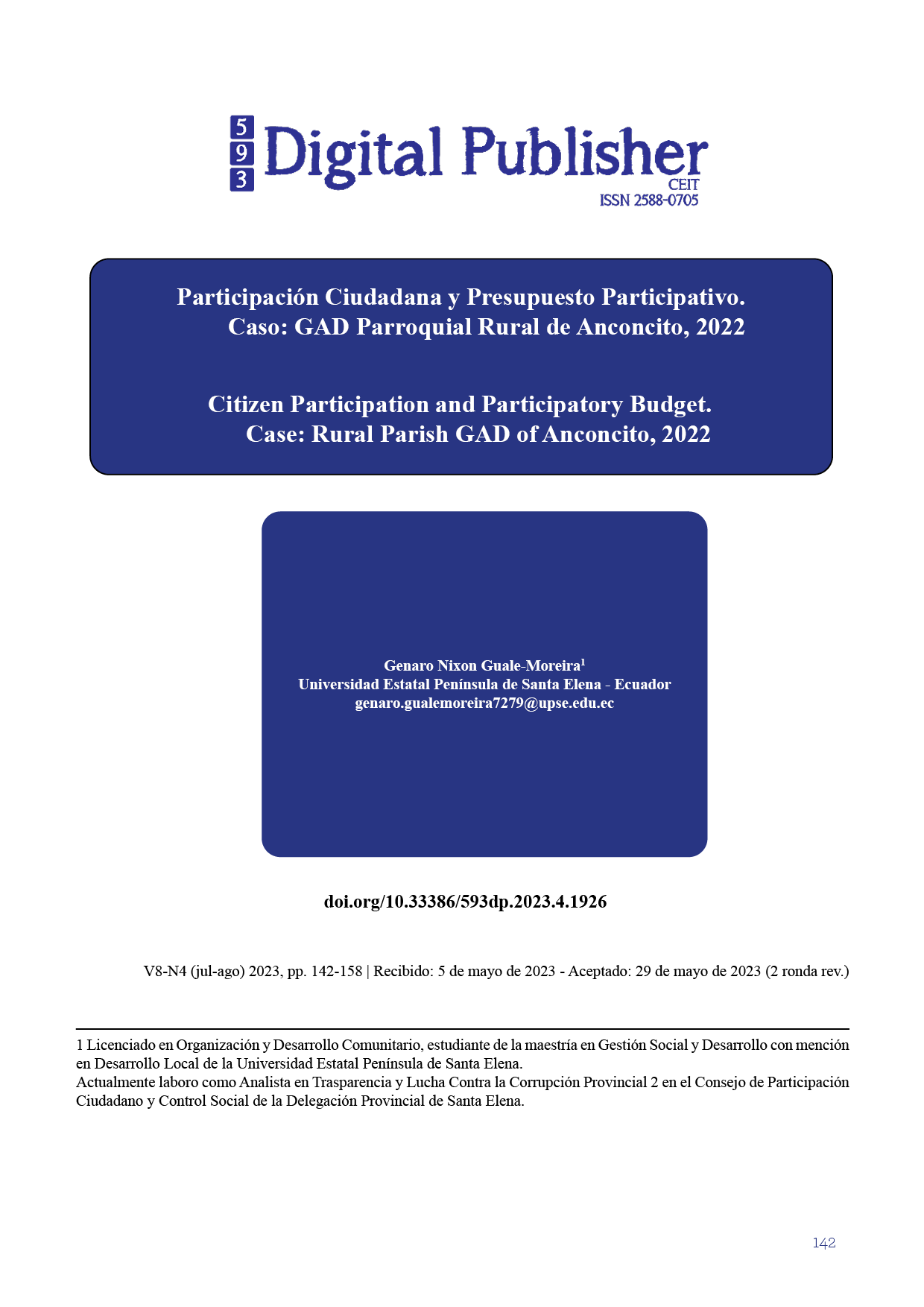Citizen Participation and Participatory Budget. Case: Rural Parish GAD of Anconcito, 2022.
Main Article Content
Abstract
Citizen participation and participatory budgeting are fundamental pillars of a solid democracy. By involving citizens in decision-making and resource allocation, transparency, inclusion, and accountability are promoted. This generates greater civic commitment, strengthens trust in institutions, and makes it possible to meet the real needs of the community in an equitable and effective manner. The objective of this research is to verify the relationship that exists between the variables of citizen participation and participatory budgeting, in order to formulate strategies that help to integrate citizen mechanisms that efficiently involve the community in the various public allocations of resources. The research was quantitative in nature with a correlational scope. Based on this approach, the hypothesis test that was applied was Spearman's, since it is adapted from the non-normality of the source data, since they result from a Likert scale. Among the main ones, a direct relationship between the variables was observed, therefore promoting citizen participation through strategies that involve the inhabitants of the parish will contribute to promoting efficient allocations in the participatory budget processes.
Downloads
Article Details

This work is licensed under a Creative Commons Attribution-NonCommercial-ShareAlike 4.0 International License.
1. Derechos de autor
Las obras que se publican en 593 Digital Publisher CEIT están sujetas a los siguientes términos:
1.1. 593 Digital Publisher CEIT, conserva los derechos patrimoniales (copyright) de las obras publicadas, favorece y permite la reutilización de las mismas bajo la licencia Licencia Creative Commons 4.0 de Reconocimiento-NoComercial-CompartirIgual 4.0, por lo cual se pueden copiar, usar, difundir, transmitir y exponer públicamente, siempre que:
1.1.a. Se cite la autoría y fuente original de su publicación (revista, editorial, URL).
1.1.b. No se usen para fines comerciales u onerosos.
1.1.c. Se mencione la existencia y especificaciones de esta licencia de uso.
References
Aparicio-Castro, B., Aguilera-Menéndez, M., & Álvarez-Benavides, C. (2018). La educación cívica como herramienta para la participación ciudadana. Revista Interuniversitaria de Formación del Profesorado, 83-95.
Arantes, R. (2017). El presupuesto participativo de Porto Alegre y su legado. Revista de Economía Crítica,, 73-91.
Asamblea Nacional del Ecuador. (2008). Constitución de la República del Ecuador. Montecristi: Constitución de la República del Ecuador. .
Banco Interamericano de Desarrollo. (2019). Presupuesto participativo. BID. Obtenido de https://www.iadb.org/es/topics/presupuesto-participativo
Bingham, L., & Nabatchi, T. (2018). The new governance: Practices and processes for stakeholder and citizen participation in the work of government. Public Administration Review, 246-251.
Bryan, L., & Baer, T. (2018). Governing in the shadow of hierarchy: Participatory governance and the challenges of institutional coordination. Public Administration Review, 283-294.
Caicedo, J. (2018). Participación ciudadana en los GAD Parroquiales de la Provincia de Manabí. Obtenido de https://repositorio.ute.edu.ec/bitstream/123456789/3108/1/T-UTE-0005.pdf
Carvalho, J., & Santos, G. (2018). The challenges of transparency in participatory budgeting: The Brazilian experience. Public Administration Review, 252-264.
Centro de Investigaciones y Estudios Especializados en Etnias y Culturas Populares (CIESECP). (2019). Encuesta de opinión pública. CIESECP. Obtenido de https://www.uasb.edu.ec/Portals/0/Documents/CIESECP/Encuestas/Encuesta-CIESECP-2019.pdf
Centro Latinoamericano para el Desarrollo Rural (RIMISP). (2017). Presupuesto participativo. RIMISP. Obtenido de https://rimisp.org/presupuesto-participativo/
Conde-Ruiz, J., & Galasso, V. (2019). La colaboración entre el gobierno y la sociedad civil: ¿cómo mejorar la calidad de las políticas públicas? Documentos de Trabajo.
Cornwall, A., & Gaventa, J. (2001). From users and choosers to makers and shapers: Repositioning participation in social policy. IDS bulletin.
Cunha, C., & Magalhaes, M. (2018). Budget participatory and transparency in public management: Analysis of a Brazilian case. RAUSP Management Journal, 385-397.
Flores, J., & Molina, I. (2019). Participatory budgeting and municipal management: Reflections on the experience of the city of Córdoba. Journal of Public Administration Research and Theory,, 404-416.
Fundación para el Desarrollo Integral de Políticas Públicas (FDIPP). (2018). Participación ciudadana en Ecuador. FDIPP. Obtenido de https://www.fdipp.org/wp-content/uploads/2018/12/Participaci%C3%B3n-Ciudadana-en-Ecuador.pdf
García, R. (2017). El presupuesto participativo como herramienta de participación ciudadana en México. Revista de Ciencias Sociales, 73-91.
García, R., & Mendoza, J. (2019). Presupuesto participativo y su impacto en el desarrollo local: el caso del GAD parroquial de Anconcito. Revista Científica de Desarrollo Local Sostenible, 75-89.
George, D., & Mallery, P. (2003). SPSS for Windows step by step: A simple guide and reference. 11.0 update. Boston: Allyn and Bacon.
Gobierno Autónomo Descentralizado Parroquial de Anconcito. (2014). Plan de Desarrollo y Ordenamiento Territorial 2014-2019. Salinas: GAD parroquial de Anconcito.
Gómez-García, A., & Martínez-Pérez, A. (2019). Participación ciudadana en la toma de decisiones públicas a través de la tecnología: retos y oportunidades. El profesional de la información.
González-Navarro, M. (2019). The impact of citizen participation on public services: evidence from rural water supply in India. Journal of Public Economics, 146-162.
Gray, M., Manoli, C., & Zeitoun, H. (2015). Three dimensions of participation: Power, democracy and legitimacy. European Journal of Political Research, 80-96.
Hinojosa, L. (2016). Participación ciudadana: instrumento para fortalecer la democracia en México. Política y Gobierno, 295-326.
INEC. (2010). Censo de Población y Vivienda. Quito: Instituto Nacional de Estadísticas y Censos.
Instituto Nacional de Estadística y Censos. (2019). Índice de Inclusión Social. INEC. Obtenido de https://www.ecuadorencifras.gob.ec/documentos/web-inec/Institucional/PublicacionesInformes/Indice%20de%20Inclusion
Instituto Nacional de Estadística y Censos. (2020). Resultados del Censo de Población y Vivienda 2020. INEC. Obtenido de https://www.ecuadorencifras.gob.ec/censo-de-poblacion-y-vivienda/
López, D., Beltrán, J., & García, C. (2020). Participatory budgeting and social inclusion.
Lovelace, K., & Saito, L. (2020). Participatory budgeting and the inclusion of marginalized populations: evidence from São Paulo, Brazil. International Journal of Public Administration, 269-178.
Ministerio de Agricultura y Ganadería (MAG). (2020). Santa Elena. MAG. Obtenido de https://www.mag.gob.ec/provincias/santa-elena/
O´Brien, D., Forest, P. G., & Kincaid, J. (2018). Inclusive public participation in health: Policy, practice and theoretical contributions to promote the involvement of marginalized groups. The International Journal of Health Planning and Managemen, 1-17.
Peñafiel, J. (2019). La participación ciudadana en la gestión pública. Revista Científica Arbitrada de la Fundación MenteClara, 1-17.
Pérez, L. (2019). Evaluación de la eficacia de los presupuestos participativos en la ciudad de Quito, Ecuador. Revista de Estudios Urbanos, 105-122.
Pires, R., & Matheus, R. (2018). Participation and deliberation in the budget process: evidence from the Portuguese Participatory Budget. Public Administration, 146-161.
Plan Nacional de Desarrollo. (2017). Plan Nacional de Desarrollo 2017-2021 del Gobierno de Ecuador. Quito: SENPLADES. Obtenido de https://www.planificacion.gob.ec/wp-content/uploads/downloads/2017/08/Plan-Nacional-de-Desarrollo-2017-2021.pdf
Programa de Naciones Unidas para el Desarrollo. (2016). Presupuesto participativo. PNUD. Obtenido de https://www.undp.org/content/undp/es/home/ourwork/democratic-governance-and-peacebuilding/participatory-budgeting.html
Rodríguez, F., & Rodríguez, A. (2021). Participatory budgeting in Mexico: perception and reality of citizen participation. International Journal of Public Administration, 34-44.
Sandoval-Almazan, R., & Gil-Garcia, J. (2015). Towards cyberactivism 2.0? Understanding the use of social media and other information technologies for political activism and social movements. Government Information Quarterly, 163-169.
Welch, & Comer. (1988). Coeficiente de Alpha de Cronbach. Obtenido de Recuperado de http://www.uv.es/~friasnav/AlfaCronbach.pdf.


